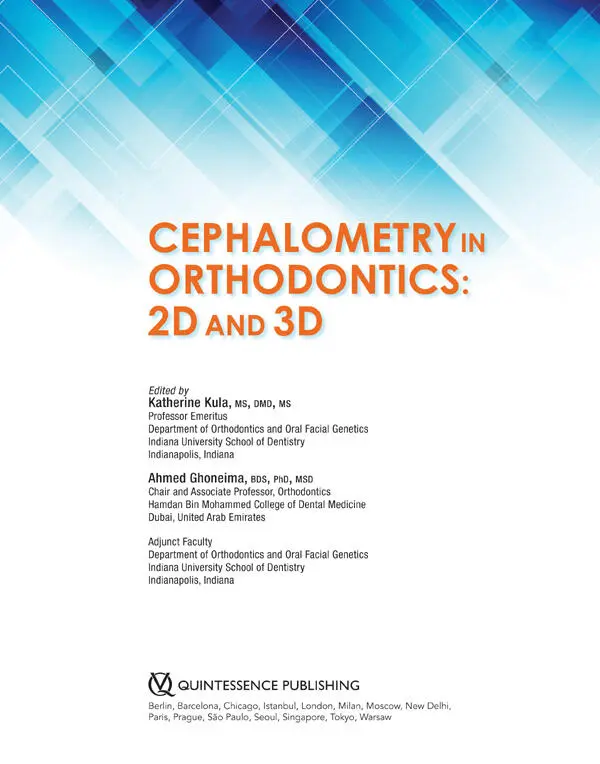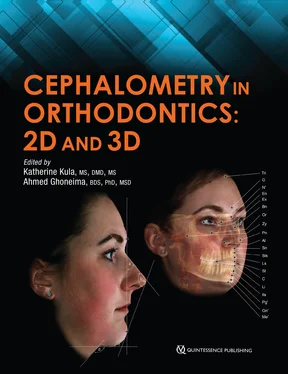Cephalometry in Orthodontics: 2D and 3D

Dedication
I dedicate this book to two important people in my life: my father, James A. Miller, Sr, who taught me the importance of hard work and the strength to persevere, and my husband, Theodore J. Kula, Jr, who taught me to question and to solve problems using the scientific method.
– KK
I dedicate this book to my late father and mother for the encouragement they blessed me with my entire life. I also dedicate it to my lovely wife and daughters for their continuous love and support. Lastly, a special thanks to many of my students whom I have had the pleasure of teaching and supervising.
– AG
Library of Congress Cataloging-in-Publication Data
Names: Kula, Katherine, editor. | Ghoneima, Ahmed, editor.
Title: Cephalometry in orthodontics : 2D and 3D / edited by Katherine Kula and Ahmed Ghoneima.
Description: Batavia, IL : Quintessence Publishing Co,Inc, [2018] | Includes bibliographical rewferences and index.
Identifiers: LCCN 2018021619 | ISBN 9780867157628 (hardcover) |eISBN 9780867158052
Subjects: | MESH: Cephalometry--methods | Orthodontics--methods | Cephalometry--instrumentation | Cone-Beam Computed Tomography
Classification: LCC RK310.C44 | NLM WU 141.5.C3 | DDC 617.6/4307572--dc23
LC record available at https://lccn.loc.gov/2018021619

© 2018 Quintessence Publishing Co, Inc
Quintessence Publishing Co, Inc
411 North Raddant Road
Batavia, IL 60510
www.quintpub.com
5 4 3 2 1
All rights reserved. This book or any part thereof may not be reproduced, stored in a retrieval system, or transmitted in any form or by any means, electronic, mechanical, photocopying, or otherwise, without prior written permission of the publisher.
Editor: Leah Huffman
Design: Erica Neumann
Production: Kaye Clemens
Printed in China
PREFACE
Successful orthodontic treatment of a patient depends on accurate diagnosis and treatment planning. The purpose of this book is to provide an updated use of clinical cephalometrics, an important part of diagnosis and treatment planning. An effort was made to minimize esoteric parameters that are not frequently used in clinical orthodontics and to introduce and broaden the aspects of the role of cephalometrics in diagnosis and treatment planning.
Currently, clinical orthodontics is transitioning from the two-dimensional (2D) world to the three-dimensional (3D) world. The use of cone beam computed tomography (CBCT) has changed from a rather myopic view that the use of 3D CBCTs could be unethical to a far broader acceptance. This has happened not only because of radiation and cost reduction but also as a result of research showing the benefits of 3D CBCTs. The unknown became the known. As equipment starts to break down, the clinician also evaluates the cost and benefit of new equipment and what his or her technologically savvy market expects. However, 2D cephalometrics is still the standard for clinical orthodontics, although many practices and orthodontic programs currently take 3D CBCTs. In reality, many practices and orthodontic programs globally are using 2D cephalometric measures with the 3D CBCTs. Thus, 2D cephalometrics is still very pertinent to patient treatment.
In order to teach cephalometrics, some history of cephalometrics is necessary but not to the degree that clinicians become lost in it. Cephalometric software programs make a plethora of analyses available for use because many clinicians do not restrict their analysis to those of individual treatment camps. Indeed, many of the cephalometric analyses are based on research or writings of multiple authors. In order to teach cephalometrics, both 2D and 3D cephalometry with their advantages and limitations need to be discussed, not as a philosophy but related to the craniofacial structures and their relationships. As research and product development increase, use of 3D measures might negate the use of 2D measures.
The addition of 3D CBCTs to cephalometry presents another dimension to the identification of skeletal and soft tissue landmarks. The transverse dimension is inherently integrated with the lateral dimension and is available for almost instant review without the viewer having to stitch separate images together. The internal structures of the face, skull, and airways can be reviewed for structural abnormalities and pathologies. The internal potentially driving structures of facial morphology can be viewed and measured more precisely in 3D. The authors integrate these possibilities with cephalometry and present currently evolving concepts and processes within cephalometry that the clinician needs to be aware of. Cephalometry, a measure of straight lines and angles of the hard and soft tissue of the face and cranium, is evolving into measures of areas and volumes that will need to be interpreted for clinical decisions and evaluation of outcomes. However, clinicians need to understand 2D cephalometry to be able to apply it better in 3D cephalometry.
Acknowledgments
Our sincere appreciation to our administrative assistant, Shannon Wilkerson, for providing assistance with typing and copying as well as allowing us to focus on our writing by running interference; to the clinical supervisor and dental assistants, Gayle Massa, Brenda McClarnon, Darlene Arnold, Shelley Pennington, and all the others, who helped us with patient records; and to the business office supervisor and other personnel, Monica Eller, Karen Vibbert, and others, for helping with patient contacts.
Note on Terminology
The hyphenation standards for cephalometric terms and landmarks used in the literature are not consistent, and many publications rely on jargon that is not universally accepted. For the sake of consistency and understanding in this book, hyphens are only used when referring to angles or landmarks that require the hyphen for clarity. Every effort has been made to remove unnecessary jargon and use clinically relevant terms and landmarks.
CONTENTS
Contributors
1 Introduction to the Use of CephalometricsKatherine Kula / Ahmed Ghoneima
2 2D and 3D RadiographyEdwin T. Parks
3 Skeletal Landmarks and MeasuresKatherine Kula / Ahmed Ghoneima
4 Frontal Cephalometric AnalysisKatherine Kula / Ahmed Ghoneima
5 Soft Tissue AnalysisAhmed Ghoneima / Eman Allam / Katherine Kula
6 A Perspective on Norms and StandardsKatherine Kula / Ahmed Ghoneima
7 The Transition from 2D to 3D Cephalometrics: Understanding the Problems of Landmarks and MeasuresManuel Lagravère / Connie P. Ling
8 Cephalometric Airway AnalysisAhmed Ghoneima / Katherine Kula
9 Radiographic Superimposition: From 2D to 3DMohamed Bazina / Juan Martin Palomo
10 Growth and Treatment Predictions: Accuracy and ReliabilityAchint Utreja
11 Measuring Bone with CBCTLeena Palomo / Tarek Elshebiny / Ali Z. Syed / Juan Martin Palomo
12 Common Pathologic Findings in Cephalometric RadiologyPaul C. Edwards / James Geist
13 The Cost of 2D Versus 3D RadiologyEric Dellinger
14 Clinical CasesAhmed Ghoneima / Katherine Kula
Читать дальше














